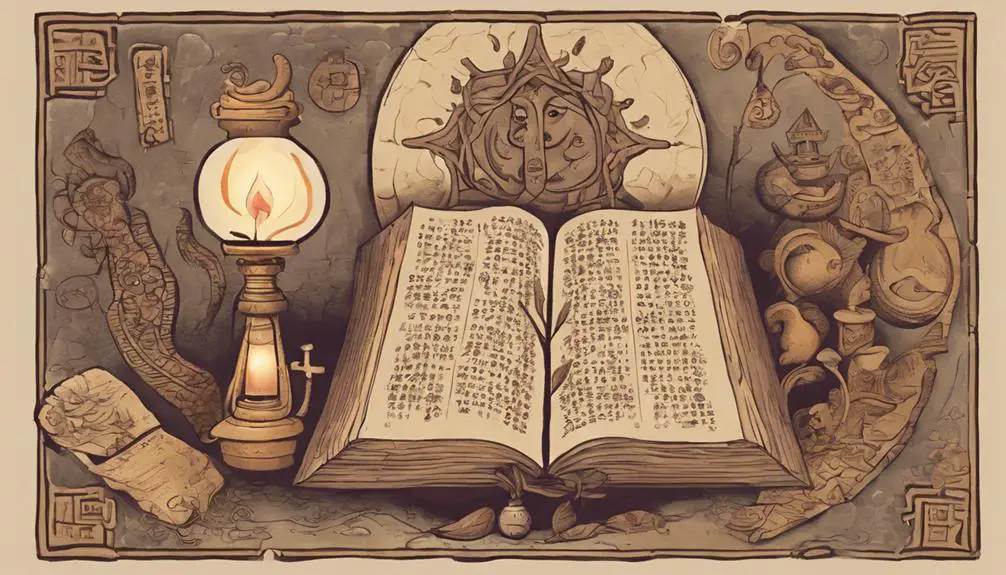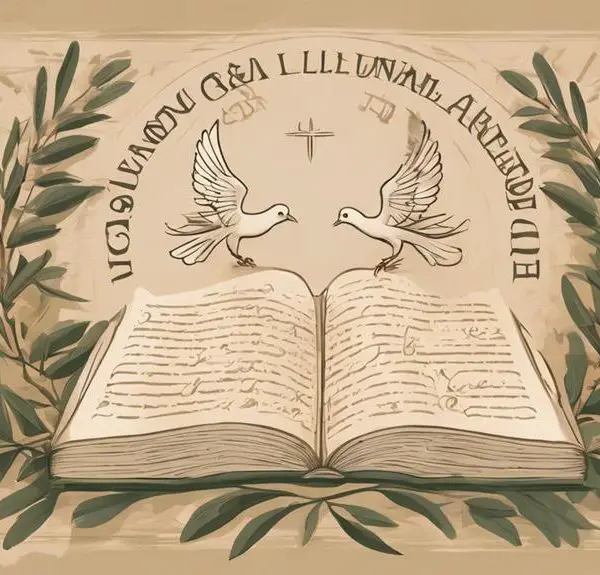Shigionoth in the Bible reveals ancient worship and poetry, inviting a deeper exploration of its mysterious and enduring spiritual significance.

Shigionoth in the Bible
Interestingly, you might have stumbled upon the term 'Shigionoth' in your biblical studies, barely giving it a second thought until now. This term, nestled within the pages of the Bible, holds a depth of meaning and tradition that's often overlooked.
As you explore its origins, occurrences, and the unique role it plays in worship, you'll uncover layers of interpretation that have influenced modern faith in subtle yet profound ways. The journey to understanding Shigionoth offers a fascinating glimpse into the poetic and musical heritage of biblical texts, inviting you to consider its impact on contemporary worship and spirituality.
Why does this ancient term still resonate today, and how does it enrich our understanding of the Bible's multifaceted teachings?
Key Takeaways
- Shigionoth is a musical term in the Hebrew Bible, indicating intense emotional expressions in worship.
- It embodies a spectrum of emotions, from deep despair to ecstatic praise, in biblical poetry.
- The practice of Shigionoth underscores the importance of music and emotional authenticity in spiritual life.
- Shigionoth has evolved but continues to influence modern worship, connecting contemporary believers with ancient biblical traditions.
Definition and Origins

Shigionoth, a term encountered in the Hebrew Bible, originates from a context that's both liturgical and poetic, signifying a specific mode or manner of musical expression. To understand its essence, you've got to delve into its linguistic roots and cultural context. The term's etymology is deeply entrenched in Hebrew, pointing towards variations of psalmody characterized by emotional intensity or ecstatic fervor. This linguistic foundation is pivotal because it not only informs you about the nature of Shigionoth but also its function within a religious setting.
In examining its cultural context, it's evident that Shigionoth was more than just a musical style; it was a conduit for spiritual expression and communal involvement. The ancient Near Eastern societies, from which this term springs, placed a high value on music's power to convey divine messages and evoke communal participation. Therefore, Shigionoth's origins aren't merely academic footnotes but are reflective of a broader societal emphasis on music as a sacred tool for connecting with the divine.
Analyzing Shigionoth through these lenses – linguistic roots and cultural context – offers a comprehensive understanding of its role within the Hebrew Bible. It wasn't just music; it was a reflection of the community's spiritual life and its relationship with the divine.
Biblical Occurrences
Having explored the origins and cultural significance of Shigionoth, we now turn our attention to its specific instances within the Hebrew Bible, where its application underscores the depth of spiritual expression in sacred texts. This exploration not only reveals the layered meanings embedded within the texts but also reflects the rich cultural context and intricate literary structure of biblical poetry.
- Emphasize the Emotional Spectrum: Shigionoth is employed to convey a wide range of emotions, from ecstasy to despair, offering a window into the spiritual and emotional life of ancient communities.
- Highlight the Complexity of Literary Structure: Its usage demonstrates the sophistication of biblical poetry, challenging readers to delve deeper into the text to uncover hidden layers of meaning.
- Illuminate the Cultural Context: Understanding Shigionoth within its occurrences provides insight into the cultural backdrop of the biblical narratives, revealing how ancient societies articulated their relationship with the divine.
- Foster a Deeper Spiritual Connection: By engaging with Shigionoth, you're invited into a more profound spiritual dialogue, one that transcends the surface level of the scriptural text and touches the core of human experience.
In this way, Shigionoth serves as a key to unlocking the literary and cultural richness of the Hebrew Bible.
Interpretations and Meanings

Delving into the interpretations and meanings of Shigionoth reveals a complex tapestry of emotional and spiritual expressions woven throughout biblical texts. This exploration uncovers layers of understanding, deeply influenced by linguistic evolution and cultural context. Shigionoth's significance extends beyond a mere literary device; it's an embodiment of intense emotional outcry or exuberant praise, reflecting the depths of human experience in relation to the divine.
The linguistic evolution of Shigionoth plays a crucial role in deciphering its meanings. As language morphed over centuries, so did the interpretation of this term, challenging scholars to piece together its significance from ancient texts. This journey through linguistics isn't just about understanding a word but about connecting with the emotional and spiritual fervor encapsulated within it.
Cultural context further enriches the interpretation of Shigionoth. It's not merely a word but a reflection of the societal values, religious practices, and expressive forms of its time. By examining the cultural backdrop against which Shigionoth was used, you gain insights into the collective psyche of the biblical era, offering a window into how people of the past expressed their most profound spiritual and emotional states.
Shigionoth in Worship
When exploring how Shigionoth manifests in worship, it's essential to understand its role in facilitating a bridge between personal expression and communal spirituality. The term, deeply rooted in the Hebrew Bible, points towards a form of worship that's both exuberant and carefully structured, blending the individual's emotional outpouring with the collective experience of faith.
Incorporating Shigionoth into worship involves:
- Utilizing musical instruments: The use of instruments, often mentioned in biblical contexts, serves not just as accompaniment but as a primary medium through which the intensity and fervor of Shigionoth are expressed.
- Acknowledging cultural influences: The cultural backdrop against which Shigionoth developed plays a crucial role in understanding its application and significance in worship settings.
- Emphasizing personal expression: Despite its communal nature, Shigionoth champions individual emotional expression, allowing for a deeply personal spiritual experience within a group setting.
- Maintaining a balance between structure and freedom: While Shigionoth encourages spontaneity and emotional release, it operates within a framework that ensures these expressions augment rather than disrupt communal worship.
Analyzing Shigionoth within the context of worship reveals its profound ability to marry personal spiritual engagement with the collective worship experience, significantly influenced by musical instruments and cultural underpinnings.
Impact on Modern Faith

As we examine the impact of Shigionoth on modern faith, it's clear that this ancient practice has significantly influenced contemporary worship and spiritual expression. The cultural relevance of Shigionoth can't be overstated. It bridges the gap between ancient biblical practices and today's diverse worship styles, allowing believers to connect with their faith's historical roots in a meaningful way. This connection not only enriches the spiritual experience but also fosters a deeper understanding of the Bible's teachings and the historical context in which they were written.
Moreover, the emphasis on historical accuracy in the study and implementation of Shigionoth in modern worship services ensures that these ancient expressions of faith are preserved and respected. This dedication to authenticity helps maintain the integrity of spiritual practices and encourages a more thoughtful and informed faith journey.
Incorporating Shigionoth into modern worship also highlights the timeless nature of expressing one's faith through music and poetry, demonstrating that these forms of worship are as relevant today as they were in biblical times. This continuity underscores the unchanging nature of the human spirit's quest for divine connection, making Shigionoth a powerful link between past and present believers.
Frequently Asked Questions
How Has the Musical or Poetic Form of Shigionoth Influenced the Structure of Contemporary Religious Music?
You're exploring how a specific form has shaped modern religious music.
Shigionoth's influence is evident in modern adaptations and festivals, intertwining ancient practices with contemporary sounds.
Analyzing this, you'll find that the structure of today's religious music often mirrors the dynamic, emotive essence of Shigionoth.
This methodical examination reveals a direct lineage, showcasing how traditional elements are reimagined to resonate with current audiences, thus perpetuating its spiritual and cultural significance.
Are There Any Notable Pieces of Artwork or Literature Outside the Bible That Have Been Inspired by or Directly Reference Shigionoth?
You're delving into diverse domains, discovering if Shigionoth exhibitions or literary analysis reveal its influence outside biblical boundaries.
Through a scholarly lens, methodically scrutinize sources, seeking signs of Shigionoth in secular settings. This exploration unearths artistic and literary works, possibly echoing its essence.
Has the Concept of Shigionoth Played a Role in Interfaith Dialogue or Comparative Religious Studies, Particularly in Discussions About Sacred Poetry or Music?
You're exploring if the concept of shigionoth has been a topic in interfaith symposiums or influenced comparative methodologies, especially regarding sacred poetry or music. It's intriguing to consider its impact on scholarly discussions, blending diverse religious perspectives.
While specific examples might be scarce, the essence of shigionoth potentially enriches dialogues, encouraging a deeper appreciation for the poetic and musical traditions across faiths, thus offering a unique lens for comparative religious studies.
Can Traces of Shigionoth Be Found in Archaeological Sites or Artifacts Related to Ancient Worship Practices?
You're exploring how ancient worship practices evolved, specifically looking for Shigionoth origins.
It's challenging to find direct traces in archaeological sites or artifacts, as the concept is deeply embedded in textual rather than physical contexts.
However, by methodically analyzing relics associated with worship, you might uncover indirect evidence of Shigionoth's influence.
This scholarly approach requires piecing together fragments of history to understand the broader evolution of religious expression and rituals.
What Are the Challenges in Translating Shigionoth Into Modern Languages, and How Have Different Translations Affected Its Interpretation and Understanding?
When tackling the translation of complex terms into modern languages, you'll face significant challenges due to varying translation methodologies. These methodologies can lead to interpretive variations, affecting the understanding and interpretation of the term.
It's crucial to consider the historical and cultural context to ensure accuracy. Different translations have resulted in a range of understandings, highlighting the importance of a methodical, scholarly approach to dissect and convey the term's nuances accurately.
Conclusion
As you've journeyed through the lyrical landscapes of shigionoth, you've uncovered its biblical roots, danced across its occurrences, and delved into its profound interpretations.
This ancient term, a beacon in worship, has echoed through the corridors of time, influencing modern faith like a river shaping the canyon through which it flows.
Your exploration reveals that shigionoth isn't just a relic of the past but a living, breathing testament to the dynamic and evolving nature of spiritual expression.



Sign up